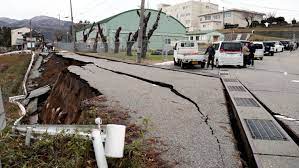Japan earthquake is a wakeup call for India
PrashantNews
The preparedness to meet the challenges of big earthquakes is undoubtedly very high in Japan. And yet the severity of a series of earthquakes which hit the island nation on Monday was enormous that left a big trail of death and destruction.
The quakes with one having magnitude of 7.6 struck on the first day of the New Year, prompting residents in some coastal areas to flee to higher ground as tsunami waves hit Japan’s west coast, sweeping some cars and houses into the sea.
Geologists in Uttarakhand who closely watched the damages caused by earthquakes said it was a wakeup call for India where the preparedness to meet big disasters was very less as compared to Japan.
With the state authorities permitting multi-storied concrete buildings in the seismic-prone areas like Dehradun, experts said the bigger magnitude earthquakes can cause on a bigger scale the death and destruction in India particularly in the Himalayan regions which are highly seismic.
“The entire Himalayan belt is highly seismic. We need to remain prepared for big earthquakes and other natural disasters always,” said Dr Sushil Kumar, a renowned geologist. He said in case of a bigger earthquake, the destruction in states like Uttarakhand will be very high.
Experts said states like Uttarakhand have moved away from its traditional earthquake-resistant houses to the concrete multi-storied buildings over the years.
Ajay Paul, senior geologist said Occurrence of earthquakes due to accumulation of strained energy under the Himalayas is a normal and relentless process. The entire Himalayan region is highly vulnerable to tremors and the strong possibility of a major earthquake is always there, Paul said.The magnitude of future earthquake might be of seven or more on the richter scale, he claimed.
Piyoosh Rautela, a top geologist, in a research paper for the DMMC has noted that Rajgarhi area in Uttarkashi District has a large number of intact multi-storied traditional houses with marked antiquity and distinct construction style. Detailed investigations suggest that the region had evolved a distinct and elaborate earthquake-safe construction style as early as 1000 yrs BP. This is known as the Koti Banal architecture. It exhibits elaborate procedures for site selection, preparing the platform for raising the structure, as also for detailing the entire structure constructed on principles somewhat akin to that of framed structures of the present times. Locally and then abundantly available wood was judiciously used in these structures. The structural detailing suggests that those responsible for designing these buildings had a fairly good idea about the forces likely to act upon the structure during an earthquake. The significant features of the Koti Banal architecture include: (i) simple layout, (ii) construction on elaborate, solid and raised platform, (iii) judicious use of locally available building material, (iv) incorporation of wooden beams all through the height of the building at regular intervals, (v) small openings and (vi) shear walls. The Koti Banal architecture, however, did not cater to the comfort of the inhabitants.
THE north-northeastward drift of the Indian plate, responsible for the evolution of the Himalayas, has not yet seized. The ongoing build-up of strain due to this movement is responsible for frequent earthquakes in the region. The entire Himalayan terrain is recognized as being highly vulnerable, Rautela said. Ends

